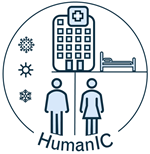Over 4 million hospital patients acquire a healthcare-associated infection (HAI) in the EU each year. Moreover, the global crisis of antimicrobial resistance means that HAI is posing an increasing cost and risk of mortality. There is clear evidence that airflow controls the dispersion and exposure to airborne pathogens and determines the contamination of critical surfaces in the human-centric climate (HCC), which is defined as the microenvironment which surrounds and is close to a human body. This points to a significant need for innovation in healthcare indoor environments to tackle the challenge of infection
control, while improving thermal comfort and energy efficiency in hospitals. To achieve this, we must both advance the fundamental understanding of how people are exposed to airborne pathogens and develop new tools and techniques to enable effective design and operation of healthcare environments. Specifically, there is a need to understand better the local influence of airflows on particles in HCC; quantify the transient behaviour of airflows and contaminants due to healthcare activities like surgery; develop methods for optimising and adapting ventilation systems to control for risks in different environments like operation rooms and isolation rooms; and develop tools to enable real-time interaction with environments during design and operational phases. Bringing together 8 leading academic teams, 4 healthcare facilities and 8 HVAC industry partners, the HumanIC network aims to build a new approach to
hospital environmental design through the concept of HCC and the training of 11 Doctoral Candidates to address these needs. HumanIC will create and disseminate fundamental and applied science to improve the knowledge base and innovate new technologies for designing and operating hospital ventilation and thermal systems and for reducing infection risk by at least 30%, meanwhile satisfying requirements of thermal comfort, safety and energy.
